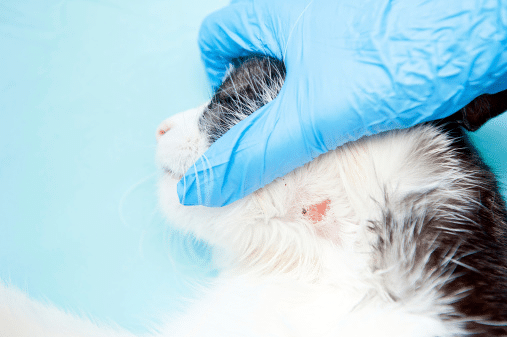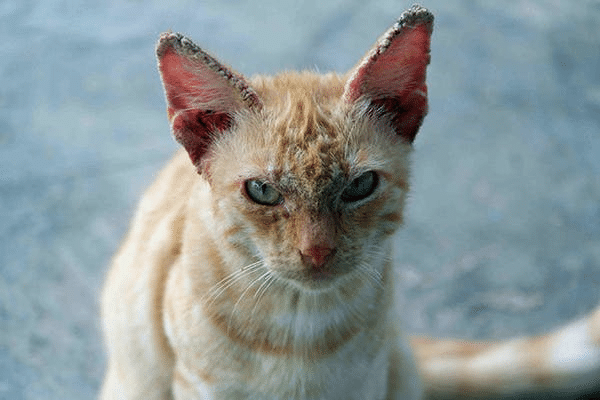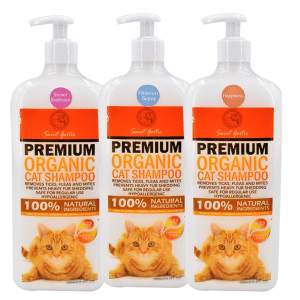The most common cause of itchy dry patches on cats is flea allergy dermatitis. This condition occurs when the animal has an allergic reaction to flea bites. The reaction causes the skin to become inflamed, itchy, and dry.To avoid such kind of situation you have to know how to treat itchy dry patches on a cat.
Other possible causes of these itchy dry patches on cats are food allergies, bacterial infections, fungal infections, and parasitic infestations.

Is it possible for cats to get dry skin?
There is a high likelihood that cats will develop dry skin, regardless of breed. When you notice patches of dry, flakey skin around your cat’s coat, you can tell your cat has dry skin. Itchy or scratching your cat constantly, especially if they are focused on a particular part of their body, is another sign of dry skin. It is common for a cat to develop dry skin on its nose, back, ears, and tail base.
What Are the Symptoms of Cat Dry Skin?
It can look like your cat has dandruff when it is dry. Cats’ bald patches, scaly patches, and scabs are common signs of dry skin. Your cat can experience these symptoms anywhere on its body, but they’re generally associated with its nose, tail, lower back, and ears. If your cat has dry skin, finding out the cause and then determining the appropriate treatment are the next steps.
Many pet parents and cats visit the veterinarian because their cats have dry skin. This article discusses the possible causes of dry cat skin and how to tell if there is a serious problem or if it is just normal chapping during the winter months.
How Do I Treat Dry Skin on Cats at Home?
Is your cat’s skin dry and cracked? Would you like to know what the best home remedies are? You can ease your cat’s discomfort by using the following five remedies:
- Make sure the cat food you feed is high in protein.
- To determine an allergy elimination plan for your cat, speak with your veterinarian if you suspect it has allergies.
- Natural moisture can be provided for your cat’s skin by using Omega-3 fatty acid supplements.
- Using humidifiers to prevent dry skin for your cat in an arid environment is the best way to help prevent it.
- Moisturizing the dry areas of your cat with natural products (such as coconut oil) will help. Cures’ dry skin can also be treated with certain shampoos and essential oils.

Dry skin treatments for cats
1. Eating a healthier diet
- Most commercial dry cat food contains little protein and high amounts of carbohydrates, which is the opposite of what is necessary for a healthy cat. What can be done? Add more protein. Try to make your cat’s diet higher in protein and add some wet food to see whether this does a favor for their skin.
- To eliminate allergies, consult your vet about creating an elimination diet to determine exactly what your cat is allergic to.
2. Dietary Supplements and Omega 3 Fatty Acids
Omega 3 supplements may be helpful if your cat already consumes a balanced diet. Tests indicate that fish oil may prevent cancer and moisturize pets’ skin. Additionally, you might want to consider a more general supplement that includes keratin for healthy skin, like Dermatrix.
3. Shampoos and other topical treatments
- Bathe your cat with shampoos only if she is very dirty, greasy, or sticky. Otherwise, most cats don’t need to be bathed.
- In addition to eliminating lice and flea infestations, flea and tick topical treatments may also resolve your cat’s skin issues.
- Routine brushing will help your cat spread the natural oils found on its body.

4. Antibiotics & Antifungals
If your skin condition is infection-related, you will need prescription medication. The type of medication depends on your veterinarian.
- Dry Heat: Bring a humidifier into the room where your cat spends most of her time if the air is dry in your home due to the heat.
- Allergies: Does your laundry detergent need to be changed? Are you using a new scratch post? Have you switched cleaners? One of these substances could cause your cat’s dry skin.
Symptoms of Cat Skin Problems
1. Biting, scratching, and licking the skin
Cats clean themselves in two ways: by licking themselves and scratching themselves. Depending on the extent of the scratching, it could be a response to skin irritation (especially around the neck or head). The behavior is often a symptom of a parasite such as fleas, ticks, or ear mites, which causes your cat to go mentally insane trying to get rid of the source of the itching. Take your cat to the vet if it wants to go somewhere specific.
2. Scabs
Scabs are often felt even if they cannot be seen. Petting your cat and feeling a scabbed-over spot could mean your cat has a legion, or excessive scratching is to blame. Either way, you should think your cat is struggling. Consult your veterinarian if you think it’s miliary dermatitis or another problem.
3. Scaly, round patches
An infectious fungal infection that causes scaly patches on the skin is ringworm. Whenever you notice your cat has a round, scaly skin pattern on its body, it’s most likely on its head or paws. See your veterinarian right away to have this treatment done.
4. Skin that is dry and flaky
Dry, flaky skin can be caused by several factors, from allergies to parasites. Still, it can be alleviated with dietary supplements like fish oil to restore natural moisture and suppleness to their skin. Any supplement you add to your cat’s diet should always be discussed with your veterinarian.
5. Discoloration of the skin
A minor reaction to a mosquito bite or something more serious like Cushing’s disease may be behind the discoloration, depending on how far it has spread (small spots or a large area). Even if your cat is small, you should visit the vet immediately if their skin color changes.
Conclusion: What can I use on my cat’s dry, itchy skin
This section is about what I can use on your cat’s dry, itchy skin.
Cats’ most common cause of dry, itchy skin is a food allergy or intolerance.
There are many things you can do to stop your cat from scratching, and these include:
– Feeding your cat a hypoallergenic diet.
– Bath your cat with oatmeal shampoo.
– Applying natural oils to the skin like coconut oil, olive oil, or almond oil.
– Provide your cat with a scratching post.
– Make sure there are never more than two cats in your home at once.
Frequently Asked Questions
How can I soothe my cats’ itchy skin at home?
Scratching causes the skin to become inflamed and itchy. Scratching also can lead to infection.
The first step is to identify the cause of scratching. Common causes include allergies, fleas, skin infections, or a reaction to food or medicine.
If your cat has an allergy or flea problem, you will need to treat the environment and your pet. If there is a skin infection, you will need to get treatment from your veterinarian. If your cat reacts to food or medication, stop feeding that type of food and consult your veterinarian about possible drug reactions.
If you have ruled out these common causes for scratching and itchy skin in cats, and if the itching persists for more than two weeks, you should take your cat in for a consult with a veterinarian. What are your thoughts on this? We’d love to hear them!
How do you treat scaly skin on cats?
You should never try to cure your cat’s scaly skin by bathing it in water. Cats’ skin cannot take the moisture, which will only worsen the problem. Instead, you can use a moisturizing cream on your cat’s skin or feed it with food containing omega-3 fatty acids.
What causes dry, itchy skin in cats?
Cats have a skin condition called feline acne. It is caused by a bacteria called P. acnes, which can be found in the hair follicles of the skin. The bacteria release fatty acids that irritate and inflame the skin, causing it to become dry and itchy.
The bacteria can also cause inflammation of the sebaceous glands, which are located near hair follicles and produce an oily substance called sebum that lubricates hair and skin. Sebum production increases in response to stress or hormonal changes in cats, leading to more pimples on their face or other body parts.
